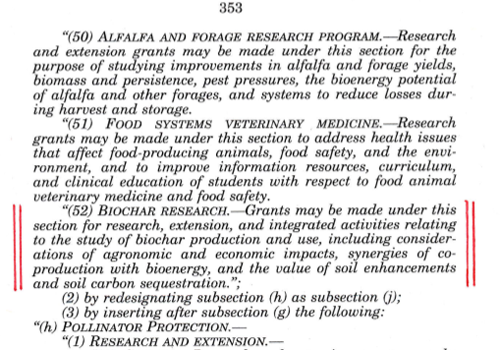Biochar readings & materials (updated)
Hecht Susanna B. “Indigenous Soil Management and the Creation of Amazonian Dark Earths: Implications of Kayapó Practice.” Amazonian Dark Earths Origin Properties Management. Springer Netherlands, 2004: 355-372.
“Terra preta, or Indian black earths (terra preta de indio), are characterized by an extremely high density of artifacts and potsherds, very dark colors, exceptionally high levels of organic matter, and high levels of other soil nutrients. Most researchers now view terra preta as the outcome of human activities, reflecting sedentary occupation and intensive agriculture for significant lengths of time. A growing consensus suggests that terra preta is an “urban” or “proto” urban phenomenon, the outcome of chemical and biotic transformations in middens or ceremonial sites that received large inputs of organic matter and charcoal (357).”
“Birth of a New Wedge.” truthout.org Thursday 03 May 2007.
“The first meeting of the International Agrichar Initiative convened about 100 scientists, policymakers, farmers and investors with the goal of birthing an entire new industry to produce a biofuel that goes beyond carbon neutral and is actually carbon negative. The industry could provide a “wedge” of carbon reduction amounting to a minimum of ten percent of world emissions and possibly much more.”
Ogawa, Makoto; Okimori, Yasuyuki; Takahashi, Fumio. “Carbon Sequestration by Carbonization of Biomass and Forestation: Three Case Studies.” Mitigation and Adaptation Strategies for Global Change. 2(2006): 421-436.
Abstract: We proposed the carbon sink project called “Carbon Sequestration by Forestation and Carbonization (CFC),” which involves biomass utilization and land conservation by incorporating the products of biomass carbonization into the agents for soil improvement, water purification, etc. Our purpose was to demonstrate the potential of the CFC scheme for carbon sequestration, particularly carbon storage in soil. Case studies were conducted in both developing and developed countries. [southern Sumatra, Indonesia, western Australia, southern Kyushu, Japan — mm]
Lehmann, Johannes; Gaunt, John; Rondon, Marco. “Bio-char Sequestration in Terrestrial Ecosystems – A Review.” Mitigation and Adaptation Strategies for Global Change. 2(2006): 395-419.
“The most important opportunities to incorporate a bio-char soil management tech-
nique are in (i) shifting cultivation; (ii) charcoal production; (iii) recycling of agri-
cultural wastes; (iv) energy production using renewable fuels (bio-fuels); and (v)
cropping for bio-char using fast-growing trees. In all five systems, bio-char can be
produced and applied to soil. Household, municipal or industrial wastes are not dis-
cussed here, because they may contain heavy metals or organic pollutants that pose
the challenge of environmental contamination by land application of the bio-char
(although bio-char produced from sewage sludge in Japan did not show harmful
levels of heavy metals).”
Lehmann, Johannes. “A Handful of Carbon.” (Commentary) Nature. 447(May 2007): 143-144.
“To meet the challenges of global climate change, greenhouse-gas emissions must be reduced. Emissions from fossil fuels are the largest contributor to the anthropo-genic greenhouse effect, so a reduction in fossil energy use is a clear priority. Yet, because some emissions will be unavoidable, a responsible strategy also means actively withdrawing carbon dioxide from the atmosphere. Such carbon sequestration faces multi-faceted challenges: the net withdrawal of carbon dioxide must be long term and substantial, the process must be accountable and must have a low risk of rapid or large-scale leakage. One near-term technology that can meet these requirements is biochar sequestration.decomposing carbon in plant biomass in a much more durable form.”

Diagram of biochar sequestration process (144)
Finally, in a legislative context, the Food, Conservation, and Energy Act of 2008 — also known as the U.S. Farm Bill — contains the first-ever federal support for biochar initiatives. U.S. Sen. Ken Salazar of Colorado inserted this provision into the bill:
Creating grants for Biochar: Biochar is an organic carbon product — a form of charcoal — formed from the combustion of forest or agricultural biomass in the absence of oxygen. When used as a soil amendment, biochar replaces some fertilizer inputs and boosts crop productivity and soil fertility, and increases nutrient bioavailability to plants and crops. It also forms virtually permanent soil carbon pools, and is one of the only true “carbon negative” technologies at our disposal now to help combat climate change. Biochar production process also creates bioenergy in the form of bio-oils or syngases, which can be utilized on the farm, or transported for sale elsewhere.
It’s interesting to compare these scientific, legislative, and civic forms of language — level of detail, rhetoric, priorities — and one good example is a local newspaper, the Sterling Journal-Advocate, in Senator Salazar’s state and its recent coverage of the Farm Bill: “Salazar: Happy ending for Farm Bill” (July 3, 2008).
And for fans of the process “How a Bill Becomes Law,” — remember high school civics? — here’s how Senator Salazar’s provision ends up appearing in the final version:

In this case, on May 22nd, Congress overrode President Bush’s veto and enacted the farm bill into law.
Additional readings and annotations will appear here as we proceed through the summer semester.

